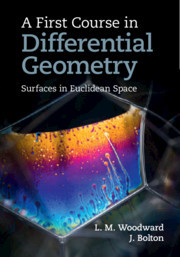Description
A First Course in Differential Geometry
Surfaces in Euclidean Space
Authors: Woodward Lyndon, Bolton John
With detailed explanations and numerous examples, this textbook covers the differential geometry of surfaces in Euclidean space.
Language: English
Subject for A First Course in Differential Geometry:
Approximative price 43.23 €
In Print (Delivery period: 14 days).
Add to cart
A First Course in Differential Geometry
Publication date: 11-2018
272 p. · 18.8x24.5 cm · Paperback
Publication date: 11-2018
272 p. · 18.8x24.5 cm · Paperback
Approximative price 90.27 €
In Print (Delivery period: 14 days).
Add to cart
A First Course in Differential Geometry
Publication date: 11-2018
272 p. · 19.2x25.2 cm · Hardback
Publication date: 11-2018
272 p. · 19.2x25.2 cm · Hardback
Description
/li>Contents
/li>Biography
/li>
Differential geometry is the study of curved spaces using the techniques of calculus. It is a mainstay of undergraduate mathematics education and a cornerstone of modern geometry. It is also the language used by Einstein to express general relativity, and so is an essential tool for astronomers and theoretical physicists. This introductory textbook originates from a popular course given to third year students at Durham University for over twenty years, first by the late L. M. Woodward and later by John Bolton (and others). It provides a thorough introduction by focusing on the beginnings of the subject as studied by Gauss: curves and surfaces in Euclidean space. While the main topics are the classics of differential geometry - the definition and geometric meaning of Gaussian curvature, the Theorema Egregium, geodesics, and the Gauss?Bonnet Theorem - the treatment is modern and student-friendly, taking direct routes to explain, prove and apply the main results. It includes many exercises to test students' understanding of the material, and ends with a supplementary chapter on minimal surfaces that could be used as an extension towards advanced courses or as a source of student projects.
Preface; 1. Curves in Rn; 2. Surfaces in Rn; 3. Smooth maps; 4. Measuring how surfaces curve; 5. The Theorema Egregium; 6. Geodesic curvature and geodesics; 7. The Gauss–Bonnet theorem; 8. Minimal and CMC surfaces; 9. Hints or answers to some exercises; Index.
Lyndon Woodward obtained his D.Phil. from the University of Oxford. They embarked on a long and fruitful collaboration, co-authoring over thirty research papers in differential geometry, particularly on generalisations of 'soap film' surfaces. Between them they have over seventy years teaching experience, being well-regarded as enthusiastic, clear, and popular lecturers. Lyndon Woodward passed away in 2000.
John Bolton earned his Ph.D. at the University of Liverpool and joined the University of Durham in 1970, where he was joined in 1971 by Lyndon Woodward.
John Bolton earned his Ph.D. at the University of Liverpool and joined the University of Durham in 1970, where he was joined in 1971 by Lyndon Woodward.
© 2024 LAVOISIER S.A.S.




